In a ceremony harking back to Thailand's Hindu roots, a statue of Brahma was paraded through the streets of Bangkok yesterday to the Erawan shrine, where worshippers were on hand to welcome the revered deity.
Thousands of people carrying incense sticks and wearing flower garlands braved the rain to celebrated the return of the Phra Prom statue that was destroyed on March 21 when a Muslim man attacked it with a hammer.
People lined the pavements and crowded the streets to cheer as white-hatted priests lifted the four-faced statue of Brahma to its former place of honor, snarling the city's notorious traffic for hours.
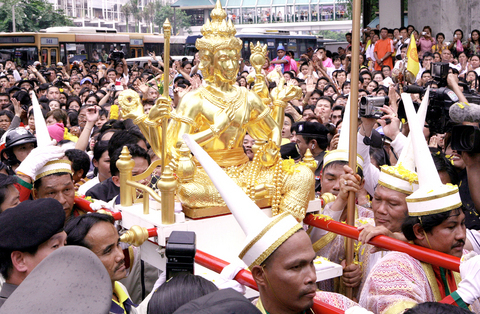
PHOTO: AFP
Vendor Boonsom Amorn, who travelled from Pathum Thani to witness the event, said any inconvenience was worth it.
"I am very satisfied," she said, her hands raised in a wai to respect a statue that many Thais believe can grant anything from a child to a fortune.
"I hope that the country will be living in peace from now on. Buddhist tourists can now come back to Thailand," she said.
The statue of Brahma, venerated by Hindus as the creator, has drawn Buddhists, Hindus and other tourists from around Asia to the shrine beside the five-star Erawan hotel.
A sign at the shrine says it was built 50 years ago to protect the Erawan hotel because the hotel's foundation stone was laid on an inauspicious day.
Devotees from Hong Kong had chartered flights for the ceremony, which was broadcast live on Thai TV and was also attended by hundreds of people from Singapore, Malaysia and other parts of Asia, Television of Thailand said.
To mark the occasion, caretaker Prime Minister Thaksin Shinawatra became the first Thai to pray at the shrine since March attack.
Many Thais interpreted the destruction of the statue as a bad omen as it happened in the midst of political turmoil between Thaksin and his opponents.
The government funded the repairs, which included elevating the statue of the deity and installing a police guard. Culture Minister Surakiart Sathirathai, who presided over the placement of the statue, said the government had made two copies, keeping the second at the National Museum in case of another mishap.
Thai musicians pounded drums garlanded by flowers as people danced in the rain, holding incense sticks aloft while waiting for their turn to pray.
"I was shocked when the statue was destroyed," said Anon Kuntiranon, a 21-year-old Bangkok office worker. "Now, he is back to help give us moral support."
"I feel at peace now that Phra Phom has returned to the shrine and we can worship him again," said Absorn Keowsopha, 52.
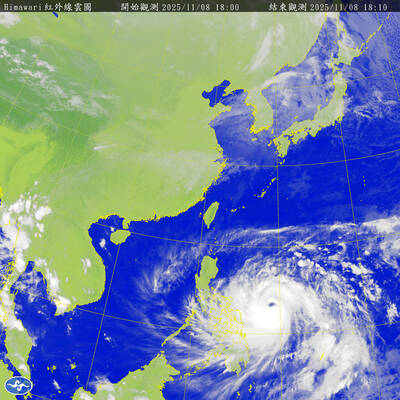
The Central Weather Administration (CWA) yesterday said it expected to issue a sea warning for Typhoon Fung-Wong tomorrow, which it said would possibly make landfall near central Taiwan. As of 2am yesterday, Fung-Wong was about 1,760km southeast of Oluanpi (鵝鑾鼻), Taiwan’s southernmost point, moving west-northwest at 26kph. It is forecast to reach Luzon in the northern Philippines by tomorrow, the CWA said. After entering the South China Sea, Typhoon Fung-Wong is likely to turn northward toward Taiwan, CWA forecaster Chang Chun-yao (張峻堯) said, adding that it would likely make landfall near central Taiwan. The CWA expects to issue a land
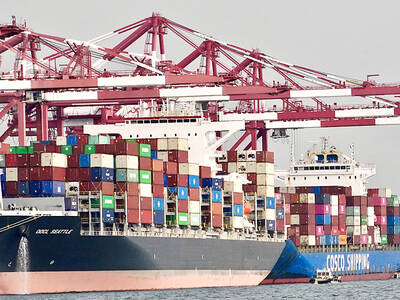
Taiwan’s exports soared to an all-time high of US$61.8 billion last month, surging 49.7 percent from a year earlier, as the global frenzy for artificial intelligence (AI) applications and new consumer electronics powered shipments of high-tech goods, the Ministry of Finance said yesterday. It was the first time exports had exceeded the US$60 billion mark, fueled by the global boom in AI development that has significantly boosted Taiwanese companies across the international supply chain, Department of Statistics Director-General Beatrice Tsai (蔡美娜) told a media briefing. “There is a consensus among major AI players that the upcycle is still in its early stage,”
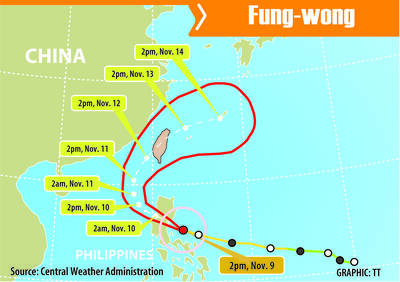
The Central Weather Administration (CWA) yesterday said it is expected to issue a sea warning for Typhoon Fung-wong this afternoon and a land warning tomorrow. As of 1pm, the storm was about 1,070km southeast of Oluanpi (鵝鑾鼻), Taiwan’s southernmost point, and was moving west-northwest at 28 to 32kph, according to CWA data. The storm had a radius of 250km, with maximum sustained winds of 173kph and gusts reaching 209kph, the CWA added. The storm is forecast to pass near Luzon in the Philippines before entering the South China Sea and potentially turning northward toward Taiwan, the CWA said. CWA forecaster Chang Chun-yao (張峻堯) said
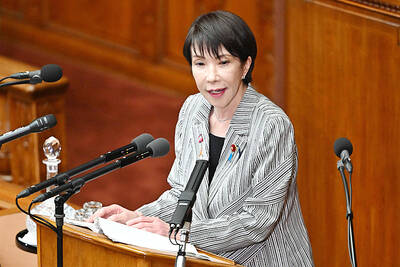
Japanese Prime Minister Sanae Takaichi yesterday said that China using armed force against Taiwan could constitute a "survival-threatening situation" for Japan, allowing the country to mobilize the Japanese armed forces under its security laws. Takaichi made the remarks during a parliamentary session while responding to a question about whether a "Taiwan contingency" involving a Chinese naval blockade would qualify as a "survival-threatening situation" for Japan, according to a report by Japan’s Asahi Shimbun. "If warships are used and other armed actions are involved, I believe this could constitute a survival-threatening situation," Takaichi was quoted as saying in the report. Under Japan’s security legislation,